Silver, Explained
While silver is often considered “second” to gold, silver has unique properties that make it attractive as both a precious and industrial metal. The following analysis seeks to shed additional light on silver by answering five key questions:
- How and where is silver extracted?
- How is silver used?
- How does silver compare to gold?
- What are silver’s supply and demand dynamics?
- What are the differences between investing in physical silver, futures, and silver mining stocks?
How and where is silver extracted?
Silver ore is mined through both open-pit and underground methods. The open pit method involves using heavy machinery to mine deposits relatively near the earth’s surface. In underground mining, deep shafts are dug into the ground to extract ore. Once ores are extracted, they are crushed, ground, and separated through a process called “flotation” to achieve mineral concentrations that are 30-40 times higher than naturally occurs. Refiners then further concentrate this extraction through the process of electrolysis or amalgamation.1
Only 28% of silver comes from mining activities where silver is the primary source of revenue. The remaining 72% comes from projects where silver is a by-product of mining other metals, such as copper, lead and zinc.2 As expected, the revenues of firms focused on primary silver production tend to be much more impacted by silver prices than firms that produce it as a by-product.
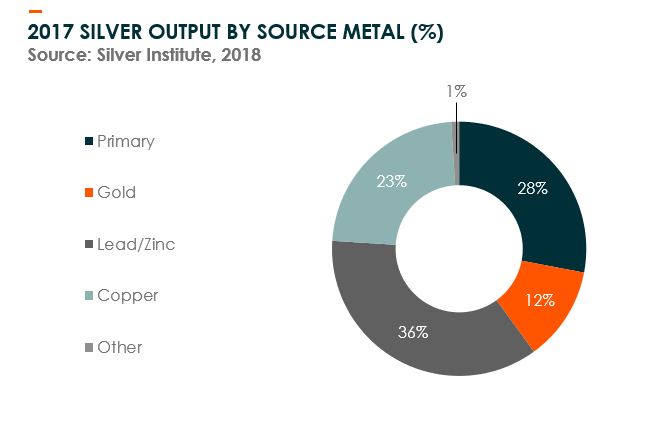
Silver can be found across many geographies, but about 57% of the world’s silver production comes from the Americas, with Mexico and Peru supplying 40%.3 Outside of the Americas, China, Russia, and Australia combine to make up nearly 22% of the world’s production.
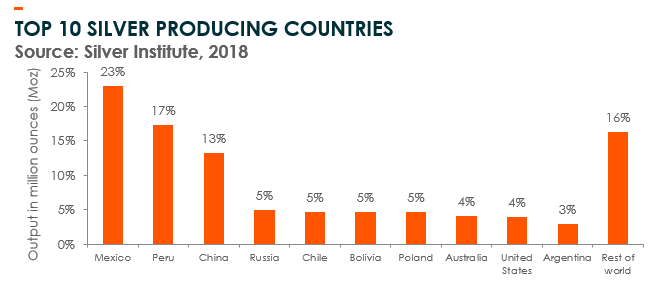
How is silver used?
For centuries, silver has been used in variety of luxury goods such as jewelry, tableware, and fine art. Today, over 40% of silver’s consumption comes from this precious metals segment. Silver is a significant material for industrial uses as well, because of its thermo-electro conductivity, ductility, malleability, and high sensitivity to light. The metal is used extensively in a variety of faster-growing electronics segments such as solar panels, LED lighting, flexible displays, touch screens, RFID tags, cellular technology, and water purification. Silver’s unique properties and the relatively small quantities of the metal required in many applications often make it an irreplaceable input, even if the price of silver rises.4
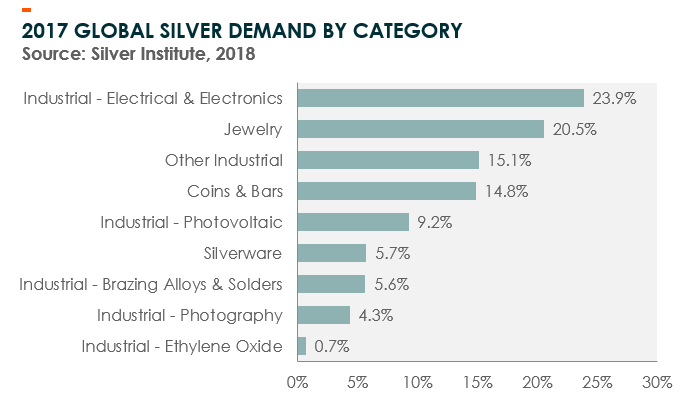
How does silver compare to gold?
Silver and gold are often compared to each other given their common classification as precious metals. There are two important differences between them to note: Silver’s industrial usage and their relative market sizes.
Industrial usage: As discussed in the section above, industrial usage of silver accounts for about 60% of its annual demand. Gold, by comparison, has only about 10% of its demand driven by industrial use, with the rest going to jewelry and gold bars.5,6 This difference means that gold is more purely a precious metal, whereas silver and its price is impacted by both demand for precious metals as well as industrial demand.
Market size: The market for gold is enormous, with its total value exceeding that of the European sovereign debt market. The market for silver, however, is much smaller and tends to be more volatile. The silver market is one-tenth the size of gold’s in London’s wholesale dealing and one-fifth the size of gold’s COMEX futures.7
The gold-silver ratio: The gold-to-silver ratio is a commonly cited figure that represents the amount of silver required to purchase one ounce of gold. This ratio tracks the prices of these metals relative to each other and can indicate when one is potentially cheaper or more expensive than usual. Over the last 30 years, this ratio has been at an average of 67. Currently the ratio is near 85, which possibly indicates that silver is undervalued relative to gold.
What are silver’s supply and demand dynamics?
Over the past five years, global demand for silver has exceeded supply. In 2017, demand outpaced supply by 810 tons.8 If investments in silver bars and coins are excluded from the analysis, however, then the supply of silver continues to exceed demand. This implies that demand for silver as a store of value and an investment can dramatically swing prices, particularly given the volatile nature of such demand. Therefore, if owning precious metals becomes more attractive to investors, then silver prices could rally significantly. Precious metals tend to become more desirable when interest rates are low, because the opportunity cost of holding a non-yield bearing asset class is lower. However if interest rates rise sharply, it could put negative pressure on the metal’s price. In addition, precious metals are often sought after when volatility is high, as investors seek investments that can potentially preserve their value even in a bear market.
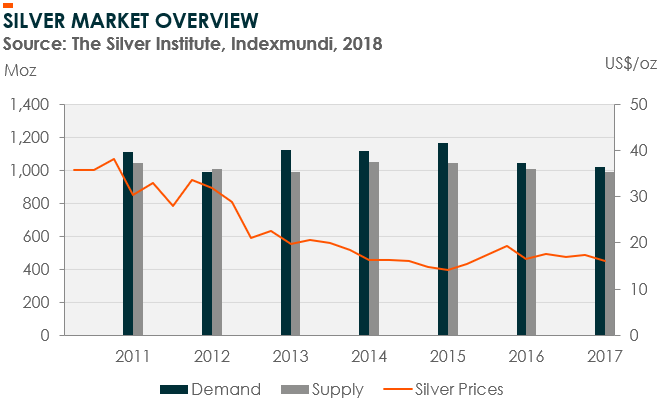
One trend that has the potential to dramatically change silver’s supply and demand landscape is increased solar power installations. It is estimated that in 2017 each gigawatt (GW) of installed solar power required 30 metric tons of silver.9,10 Given its high electrical and thermal conductivity, a silver paste is used in roughly 85% of photovoltaic cells.11 In 2017, new solar installations amounted to 99 GW12, with solar representing approximately 9%13 of silver’s total demand. Analysts estimate however that 2023 could witness 120 GW of new solar capacity.14
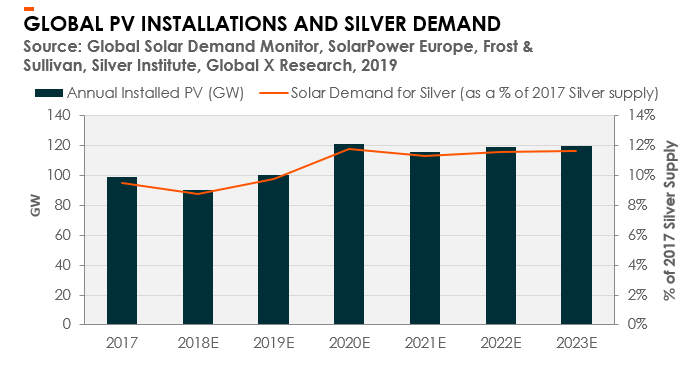
What are the differences between investing in physical silver, futures, and silver mining stocks?
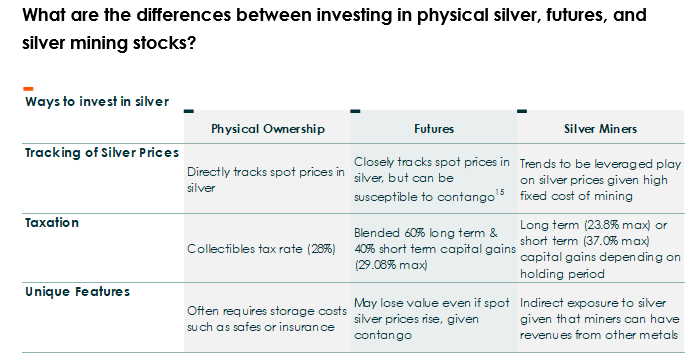
Physical Silver: Silver bullion can be bought directly from precious metal dealers, who sell it at spot market prices. The advantage of physical ownership is that its value closely tracks the price movements of the broader silver market. This also allows owners to potentially physically possess the metal, giving them direct access to their investment. One downside is that dealers can charge premiums to buy and sell silver, which can dramatically reduce returns. In addition, there can be costs of storage, such as buying a safe or renting a safety deposit box. Moreover, when an investor sells physical silver, gains are currently taxed at a maximum of 28%.
Silver Mining Stocks: Silver mining stocks can offer indirect exposure to silver prices. These stocks tend to be leveraged plays on silver prices, owing to the high fixed costs of extracting the metal. Mining stocks are considerably more liquid than physical silver as they can be bought and sold during market trading hours. Silver mining stocks can also be advantageous from a tax perspective, as long term holders are taxed at long term capital gains rates, which are currently at a maximum of 23.8%. A potential drawback is that investors are exposed to idiosyncratic risks associated with owning the stock of a particular company. To counteract this, investors may look to an ETF which owns a broad basket of companies involved in silver mining, such as the Global X Silver Miners ETF (SIL).
Futures: Paper trading of silver is conducted through the futures market. Paper trading provides investors with exposure to silver without needing to physically hold the metal, potentially improving liquidity and reducing the cost of ownership. Unlike the bullion market, futures markets can also allow investors to use leverage. One downside of futures is contango15, when future prices of a commodity are higher than their spot price. This can erode gains over time, even if the spot price of silver rises.
Conclusion
Silver is a unique metal because it has properties of both a precious and industrial metal. We believe this makes silver a useful portfolio holding as it can potentially appreciate in both environments where demand for precious metals rising, such as during periods of heightened volatility, as well as in eras of strong economic growth where industrial demand is expanding. For long term investors, we believe that a basket of silver mining stocks is a desirable way of gaining exposure to silver given their leveraged exposure to the underlying metal’s price movements and their favorable taxation compared to physical silver and futures.
Related ETFs:
The Global X Silver Miners ETF (SIL), invests in silver mining companies around the world.

